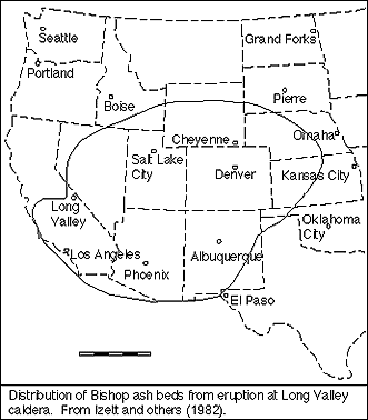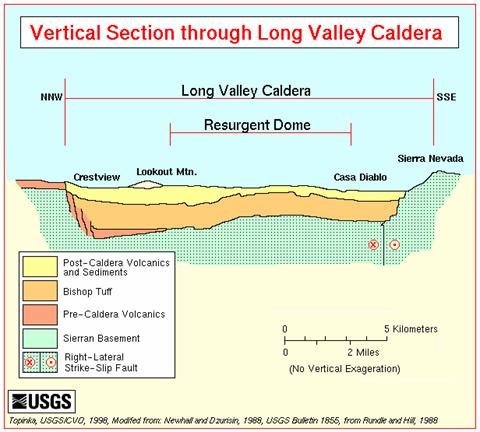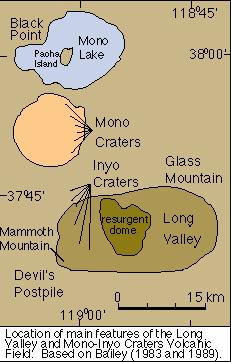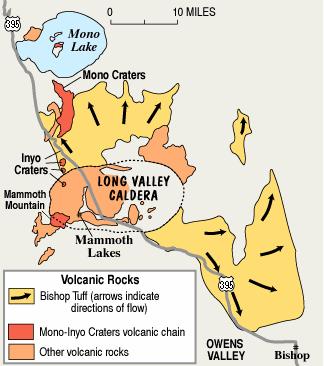Geology and Natural Heritage of the Long Valley Caldera
A Brief Look at Long Valley Caldera
and the Features Within
Katie Avers
ABSTRACT
The Long Valley caldera formed through magmatic processed that continue to affect the landscape of the caldera today. From domes to thermal springs to craters to high carbon dioxide. The patterns of the magma give scientists an idea of what magma can and will do, but makes it impossible to tell when these events will happen.
INTRODUCTION
The Long Valley caldera formed hundreds of thousands of years ago in the middle of a glacial valley. Magma caused the massive reuption as well as many of the features that continue to evolve the landscape today. The caldera has evolved from a large valley to it's present day state with new features providing new questions as to when and where the next eruption will be.
The Long Valley Caldera is located in Eastern California between the Basin and Range and the Sierra Nevada, adjacent to Mammoth Mountain. The Caldera is seventeen by thirty-two kilometers in an elliptical shape. The height of both the walls and floor vary from one side to the other; the eastern floor is higher than the western, but eh western walls are higher than the eastern. The eastern floor reaches an elevation of 2600 meters and the wall rises about 150 meters above. The western floor reaches an elevation of 2000 meters and the wall extends to an elevation of 9800 meters to 11500 meters.
According to Wikipedia, about 3.6 million years ago, volcanic activity began in what is now the Long Valley Caldera. Lava flows of rhyodesite began covering a 4000 square kilometer area. Between 2.1 and 0.8 million years ago, domes and lava flows of began releasing high silica magma which formed Glass Mountain, located on the northeast edge of the soon-to-be Caldera. Geologists believe this was a sign of the magma chamber below the surface growing. The Long Valley Caldera formed 760,000 years ago after a cataclysmic eruption of these domes.
The Long valley eruption started when silica-rich rhyolitic magma ascended to the surface through fractures. The gas was trapped in the magma because it was so viscous and there were so many rocks creating a large explosion. The foamy lava sped down the valley as a pyroclastic flow carried ash away. During the eruption, 600 cubic kilometers of high-silica rhyolite were erupted from this magma chamber (USGS). This caused an extensive scattering of the Bishop Tuff. Approximately one half of the tuff was dispersed through a pyroclastic flow leaving thick, hundreds of feet deep, layers of sediment. The wind blew some of the material up to forty kilometers to the east.
The rest of the material merely landed within the caldera, partially filling up the caldera. The eastern floor has a higher elevation than the west because of this distribution in addition to the wind direction at the time of the eruption. The only structure that survived the eruption is the obsidian Glass Mountain. The caldera itself was caused by the emptying of the magma chamber and most of the material from within the chamber to move on top of the emptied chamber. This weight was to heavy for the chamber to support causing the chamber to collapse.
After the massive event of the forming of the caldera, volcanic activity continued, releasing crystal-free rhyolite. Pressure continued to increase in the magma chamber, which pushed up on the rocks in the caldera producing the emergence of the resurgent dome. This occurred about 100,000 years after the caldera was formed.
Eruptions along the rim of the resurgent dome every 200,000 years for the last 500,000 years have created rhyolitic domes from lava flow. The Mono-Inyo Craters were formed along fissure system with a northern inclination in the caldera. They are fashioned in a line from Mammoth Mountain through the western edge of the caldera and ends at the northern shore of Mono Lake. These domes, the Mono-Inyo Craters, are made of the most recent lavas from the Long Valley magma chamber.
The craters to the North are the Mono Crater, which are phreatic volcanoes, which have all been blocked by rhyolite domes which has corked many of them. High-silica rhyolitic eruptions created the Mono Craters over the past 40,000 years. The twenty four domes of the Mono Crater chain were caused by rhyolitic volcanism approximately 35,000 years ago. The youngest of these formed 600 years old. The northernmost of these is Panum Crater, which consists of both a tuff ring and a rhyolitic dome. The Tuff ring surrounds the rhyolitic dome, which forms a plug-dome. It was created by multiple events. The first was a steam eruption, which looks like a geyser. This occurred when hot magma reached groundwater turning it into steam. This sudden eruption broke rocks in the ground surrounding the outbreak, which creates a crater. The debris that was sent into the air landed around the vent creating a pumice ring. After this aggressive eruption magma rose toward the surface creating a dome by thick magma coming to the surface, cooling, then more magma layering on top. Magma kept pushing up and broke the cooled, and hardened, magma which fell to the side of the dome. There was so much of this broken magma that it formed a breccia. Magma continued to push up through the cracks of the dome, which has created spires sticking up through the rest of the rock.
The southern craters are the Inyo craters which are phreatic or steam explosions or rhyolitic domes. This chain was formed from low-silica rhyolitic steam eruptions over the past 5,000 years. The two southern-most craters were formed by steam eruptions. They both have pools of water at the base. North of these are five rhyolitic domes composed of pumice, obsidian, and rhyolite. They are Deadman Creek Dome, Glass Creek Dome, Obsidian Dome, and Wilsons Butte. The Inyo Crater chain is on the northwest rim of the caldera. They were formed 6,000 to 500 years ago. As Mentioned above, some of the eruptions from the Inyo craters have been Phreatic, which produced many craters, like those at the Deer Mountain.
These craters have been erupting over the past 3,000 years. The intervals vary from crater to crater but they occur in intervals of less than 1,000 years. The most recent eruption was between 1720 and 1850 from Paoha Island, a volcano in Mono Lake.
Black Point is on the northwest edge of Mono Lake. After the glaciers from the last ice age melted, Mono Lake was much larger than it is today. 13,000 years ago, a volcano formed underwater and as magma came to the surface, it immediately cooled because of the surrounding water. Because the lava cooled so quickly, the top of the volcano split open creating several long cracks, or fissures. The fissures all have a north-south orientation and vary in size, but are no wider than a couple of meters, are 30 to 70 meters deep and are hundreds of meters long. From inside the fissures, there are layers of tuffa, ash, and other evidence of the underwater cooling of magma. As the water level of the lake dropped after the ice age, the volcano emerged from the lake uncovering the fissures. Black Point is now a collection of ash and cinders with some vegetation.
Bishop Tuff is the thick deposit from the Long Valley eruption. Approximently 1500 square kilometers are covered with Bishop Tuff reaching thicknesses of up to 200 meters. It is formed from pyroclastic flow, but has crystallization and can be welded, causing a variety of features. The Bishop Tuff is concentrated within the Casa Diablo Mountain Quadrangle. Bishop Tuff is young in geological time and is within an area of young volcanic activity. 1500 meters of Bishop Tuff has been buried by new strata, some is Sherwin Till which is also below the Bishop Tuff, and have only been discovered by recent drilling through the subsurface.
The Bishop Tuff varies is color; some is light colored ash, some is darker pumice. Further down is more consolidated, or welded, tuff. Welded tuff is caused by the compression of tuff by flows on top adding pressure to the tuff below. Because of the ongoing tectonic movement, some of the tuff is molded after it has cooled. The Owens river Gorge has two layers of tuff, the bottom layer is highly welded tuff. The top layer is highly jointed and created a column effect. One theory as to how these joints form in this matter is that each column is formed by a fumeral. Each piece surrounds a center that is the fumeral. The horizontal pieces form from the heat flow and the vertical forms perpendicular to the heat flow.
Because tuff is an insulator and high temperatures boost secondary crystallization, Tuff has layers with a variety of crystallization and compression. There are two ways tuff crystallizes: devitrification and vapor-phase crystallization. Crystals that form within the glass fragments are devitrified and crystals that form in the pore space and fragments are vapor-phase. Although where the crystals form difer, they both form alkali feldspar and silica polymolymorphs. Bishop Tuff has crystals of quartz, oligoclase, and biotite and smaller pieces of sanidine, zircon, apatite, and magnetite. Devitrification, like welding, is promoted by high temperatures and by thick deposits, so densely welded areas are also devitrified. Like crystallization, there are different levels of welding; dense welding, partial welding, and no welding. When there is no welding, the material has the same texture as the original deposit, the look changes as there is more welding. The density also changes from 1.4 to 2.2. Because so much bishop Tuff landed back on the caldera floor, the tuff is one of the main contributors to the collapse of the caldera.
The Long Valley caldera, like the rest of the west, is highly affected by water. Most of the volcanic deposits that can be seen throughout the Long Valley caldera have been affected by water. Some of the volcanic material has been cooled by water, some has been altered by water. Some of the landforms have been created by water mixing with hot molten material, turning the water into steam which affects the materials around it. Hot water, or hydrothermal, systems have made the chemical and physical properties of he caldera and the landforms within it. The Caldera has an active hydrothermal system with features such as fumeroles, mineral deposits, and hot springs. The eastern side is host to many hot springs, including hot creek, because the land elevation is lower than the other end. In the higher elevated western end there are many fumeroles. The resurgent dome is home to mineral deposits caused by thermal activity. The hydrothermal system in Long valley caldera is rejuvenated by snow melt from the mountains, mostly from the western and southern edge of the caldera.
The inyo craters were formed when groundwater met hot magma causing an explosive eruption. Water causes oxidation, a chemical change, on the rocks leaving orange spots on the rocks. Minerals are being dissolved and created at the same time when oxidation occurs and what chemical change happens varies due to pressure, temperature, and other variables. The “rusty” look that many rocks get is due to hematite, lionite, and jarosite which are all iron rich. Ore deposits are caused by water leaching out some minerals while the magma cools, or hydrothermal alteration. The largest hot springs are in Hot Creek Gorge where eighty percent of the thermal water discharge occurs. Hot Creek is a stream where hot springs occur, changing the water temperature from cold snow melt to boiling spring water at points. The hot springs can change the water up to five degrees Celsius. The use of the warm spring water in the Hot Creek Fish Hatchery increases fish production because trout grows faster in warmer water than in the cold snowmelt.
Casa Diablo has wells drilled into the ground that tap into the power provided by hydrothermal systems. Unlike many other ways of harnessing power, geothermal power does not involve any burning, geothermal energy comes from tapping heat that is already in the Earth's mantle. These geothermal wells pump the hot water to three hydrothermal power plants where the water heats isobutene to harness the energy. The heat then turns turbines to generate electricity. Sometimes the steam is circulated through heat exchangers to extract the energy. The water is then pumped back into the ground where eventually it may end up back at the power plant. The isobutene is also reusable. These three plants combine to make about 40 megawatts of electricity, some of which is used by the plant to provide the needed power to keep it running. How much water can be pumped varies due to; earthquakes, crustal deformation, geothermal fluid production, and precipitation. An earthquake can open or close vents and can change the water levels both benefiting and hurting the plant. Crustal deformation causes a change in pressure on the water, usually lowering the pressure, but generally occurs while the water levels are raised, so there is not a large difference in the amount of water that is able to be taken out. Geothermal fluid production has lowered in some wells due to the use of the water. When one well, CW-3, increased production to provide water for all three plants, the water level reduced substantially. The further into the crust the well is dug the hotter the water, the temperature raises about two degrees Celsius for every one hundred feet deeper.
Geothermal power is thought of as a renewable energy source because the water can be reused. However, because the steam comes from porous rocks, many minerals are carried along through the pipes, which then have to be cleaned or the minerals will clog the pipes and equipment. Sometimes the water is not infused back into the ground causing the water and heat to be used and no longer renewable. Because of these factors geothermal power is not completely a renewable energy source, but it is more reusable than coal, nuclear, and other energy sources.
Since 1980scientists have been monitoring the Long Valley caldera much closer than before. In 1980 there was a swarm of earthquakes. Geologists noticed that part of the caldera had risen one foot since 1979 and continued to rise. The first earthquake that ended the low quake activity that has been occurring for decades was in 1978. Since this earthquake there has been a period of unrest. The largest swarm, and the swarm that got geologists full attention, was the swarm in 1980 when four strong earthquakes occurred in the same day. This gives scientists evidence that there is magma moving into the magma chamber below the Long Valley. There has also been movement along the faults which is another indicator of magma on the rise. In the 1990's trees near Mammoth Mountain began dying off due to raised levels of carbon dioxide in the ground. The carbon dioxide level is high because of magma rising in the fissures below Mammoth Mountain. Scientists believe that this is the first activity from Mammoth Mountain in 250 years because that is the age of the oldest tree in the area (USGS). This in addition to the earthquakes and movement along the faults has caused USGS to be prepared for an emergency. Because of the heightened activity, geologists have established procedures for conditions that may occur and have also had heightened monitoring of the area. Another effect of this unrest is the effect of the water being heated even higher than normal in the springs and mantle. The magma that is rising is heating the steam vents that are used to provide energy at the power plants and is also used to heat the hot springs. Because of the water temperature in the springs being raised, parts of Hot Creek have been blocked off to the public so people will not get burned.
Volcanic unrest is a massive sign that there will be a volcanic eruption at some point even though it is impossible to tell when. Luckily for us volcanic processes usually evolve at a slow pace, meaning that hopefully the next large eruption will be hundreds, if not millions of years in the future. Although the last volcanic eruption known was the eruption in Mono Lake 200 years ago, another eruption could happen that prompts the entire chamber below Long Valley to erupt. Because of heightened seismic activity, raising of the caldera, and high carbon dioxide emissions there is evidence that there will be an eruption. The question now is when?
The Long Valley caldera has evolved from foothills to a volcano to it's current state as a caldera. Although signs of volcanic unrest occur, when an eruption might happen is unknown. Most likely what will happen is that one smaller eruption will blow causing other volcanoes around it to erupt as well causing another massive eruption. The question is not if will an eruption that blows throughout the caldera will happen, but when.
Works Cited:
"About the Bishop Tuff." Maricopa community college. 6 Aug. 2007 <www.mcli.dist.maricopa.edu/show/what/warmup2.html>.
“Future Eruptions in California 's Long Valley Area-What's Likely?.” 6 Aug. 2007 <pubs.usgs.gov/fs/fs073-97/>.
Hill, David P., comp. Long Valley Caldera, California, 19782004 . USGS. 6 Aug. 2007 <w-cal.csa.com>.“Mono-Inyo Craters.” 6 Aug. 2007 <en.wikipedia.org/Mono-Inyo_Craters>.
"Living with a Restless Caldera-Long Valley , California ." May 2000. USGS. 6 Aug. 2007 <pubs.usgs.gov/fs/fs108-96/>.
" Long Valley Caldera and Mono-Inyo Craters Volcanic Field, California ." 6 Aug. 2007 <volcano.und.edu/vwdocs/volc_images/nrth_america/california/long_valley.html>.



